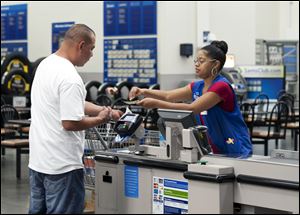
Consumer spending in May was disappointingly weak
6/26/2014
Conquisia Tyler, right, gives change to a customer at Sam's Club in Bentonville, Ark. Consumer spending rose just 0.2 percent last month after no gain in April.
WASHINGTON — U.S. consumers stepped up their spending only modestly in May, a disappointment to economists who said the weaker-than-expected gain will likely mean less of an economic rebound in the April-June quarter.
Spending rose just 0.2 percent last month after no gain in April, the Commerce Department said today. The two months followed a robust spending surge of 0.8 percent in March.
Income rose a solid 0.4 percent in May after a 0.3 percent April gain.
The 0.2 percent gain in spending was just half the increase that analysts had been expecting and some said unless June shows a very large gain, spending may not provide as much support to the economy in the second half as they had been expecting.
Paul Dales, senior U.S. economist at Capital Economics, said that consumer spending may end up rising at an annual rate of 1.7 percent in the April-June quarter which he said “wouldn’t be much of a rebound” from the sluggish 1 percent growth in consumer spending in the first quarter.
Consumer spending is closely watched because it accounts for 70 percent of economic activity.
Dales said that strength in other areas should still lift overall economic growth to around 3 percent in the current quarter, a much better showing than the 2.9 percent drop in economic output in the first three months of the year.
Jennifer Lee, senior economist at BMO Capital Markets, agreed that the spending figure was pointing to economic growth of around 3 percent in the second quarter, instead of the 3.8 percent she had forecast.
An inflation gauge that’s closely monitored by the Federal Reserve has risen 1.8 percent over the past 12 months through May, the fastest rise since late 2012 but still below the Fed’s 2 percent target.
In May, spending on durable goods jumped 0.7 percent, a rebound after having fallen 0.9 percent in April. In May, auto dealers reported their best sales month in nine years, helped by brisk demand for SUVs and pickup trucks.
Sales of nondurable goods rose 0.2 percent in May after a stronger 0.4 percent April gain, while spending on services such as rent and utilities increased a modest 0.1 percent.
The inflation gauge the Fed watches edged up 0.2 percent in May. The 1.8 percent increase over the past 12 months was up from a 12-month increase of 1.6 percent in April and increases of 1 percent or less for much of the past year.
But the Fed at its meeting last week expressed no concerns about the slight uptick in inflation. It was a signal to financial markets that the Fed is comfortable keeping interest rates at record low levels for now to give the economy a boost. Many analysts believe the Fed’s first rate hike will not occur until the summer of 2015.
The government reported Wednesday that overall economic growth, as measured by the gross domestic product, shrank at an annual rate of 2.9 percent in the January-March quarter. That’s the biggest drop since the depths of the recession five years ago.
But analysts said the big dip reflected temporary facts such as harsh winter weather that cut into consumer and business activity. In addition, businesses cut back on restocking and companies reduced their spending on new equipment and the trade deficit significantly worsened.
Analysts see all those trends reversing in the current quarter and they expect growth to rebound but with May’s disappointing spending increase, they said the rebound may be closer to 3 percent growth rather than the 3.5 percent to 4 percent they had been forecasting.
Analysts expect that the economy will keep expanding in the second half of the year with growth around 3 percent as consumer spending is aided by strong gains in employment, rising consumer confidence and gains in the stock market and home prices which will make people feel wealthier and thus more willing to spend.